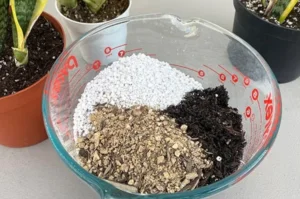Snake plants (also known as Dracaena trifasciata or mother-in-law’s tongue) are a popular and low-maintenance houseplant choice. Their striking leaves and resilience make them a favorite. However, even easy-going plants like snake plants need some care, and pruning is one of those tasks. Let’s delve into the challenges of pruning snake plants and how to find solutions.
1- Tough Leaves
One of the first challenges you may face is the toughness of the leaves. Don’t underestimate their strength! Regular scissors might not do the job. You can check out the essential tools for pruning a snake plant to ensure you’re using the right equipment.
Solution:
Use sharp pruning shears or a knife specifically designed for gardening. Clean cuts promote faster healing and reduce the risk of infection.
2- Dense Foliage
A mature snake plant’s tightly packed leaves can make it difficult to access the leaves you need to prune, especially those near the soil line.
Solution:
- Gently tilt the pot to allow better access to the base of the plant.
- Consider briefly removing your plant from its pot. This provides full access to the root area for removal of damaged leaves and for repotting if needed. For more details on safe pruning techniques, read how to prune a snake plant safely.
3- Overgrown Roots
Sometimes you might not even be pruning the leaves but the roots! An overgrown root system in a pot can impact your plant’s growth.
Solution:
Carefully remove the plant from its pot and inspect the roots. Use a clean pair of pruning shears or scissors to trim any excess roots, taking care not to damage the healthy ones. Repot the plant in fresh soil, ensuring that the roots have enough room to grow. Learn more about snake plant care after pruning.
4- Risk of Over-Pruning
While pruning is essential for maintaining a healthy snake plant, there’s always a risk of over-pruning, which can stunt the plant’s growth or even kill it altogether.
Solution:
Be conservative. Remove only damaged, diseased, or very leggy leaves at the bottom unless absolutely necessary. Pruning for shaping should be minimal. Understanding why we should prune a snake plant can help you determine the right approach.
5- Disease Spread
Pruning tools that aren’t properly sanitized can spread diseases from one plant to another, increasing the risk of infection and compromising the health of your snake plant.
Solution:
Before pruning your snake plant, ensure that your pruning tools are clean and sanitized to prevent the spread of diseases. Wipe the blades with rubbing alcohol or a disinfectant solution between uses to eliminate any pathogens. Learn about common issues when pruning a snake plant.
6- Aesthetics
Maintaining the aesthetic appeal of your snake plant can be challenging, especially if you’re unsure how to prune it properly. Improper pruning techniques can result in a misshapen or unattractive plant.
Solution:
Take the time to research proper pruning techniques for snake plants, or consult with a gardening expert for guidance. By understanding how to trim your plant correctly, you can ensure that it retains its beautiful appearance.
7- Propagation Challenges
Snake plants can be propagated from leaf cuttings, but this process can be challenging for beginners. Knowing when and how to take leaf cuttings and propagate new plants can be daunting
Solution:
Educate yourself on the propagation process for snake plants, and practice taking leaf cuttings until you feel comfortable with the technique. Consider starting with a small number of cuttings to gain experience before attempting larger-scale propagation. Understanding when to prune a snake plant can also help optimize the propagation process.
Additional Tips:
- Timing is key: Prune in the growing season (spring/summer) for faster recovery.
- Sanitation: Keep your tools and work area clean.
- Less is more: Snake plants thrive with minimal pruning
Remember, pruning doesn’t have to be stressful. With a gentle touch and these tips, your snake plant will be healthy and looking its best!






